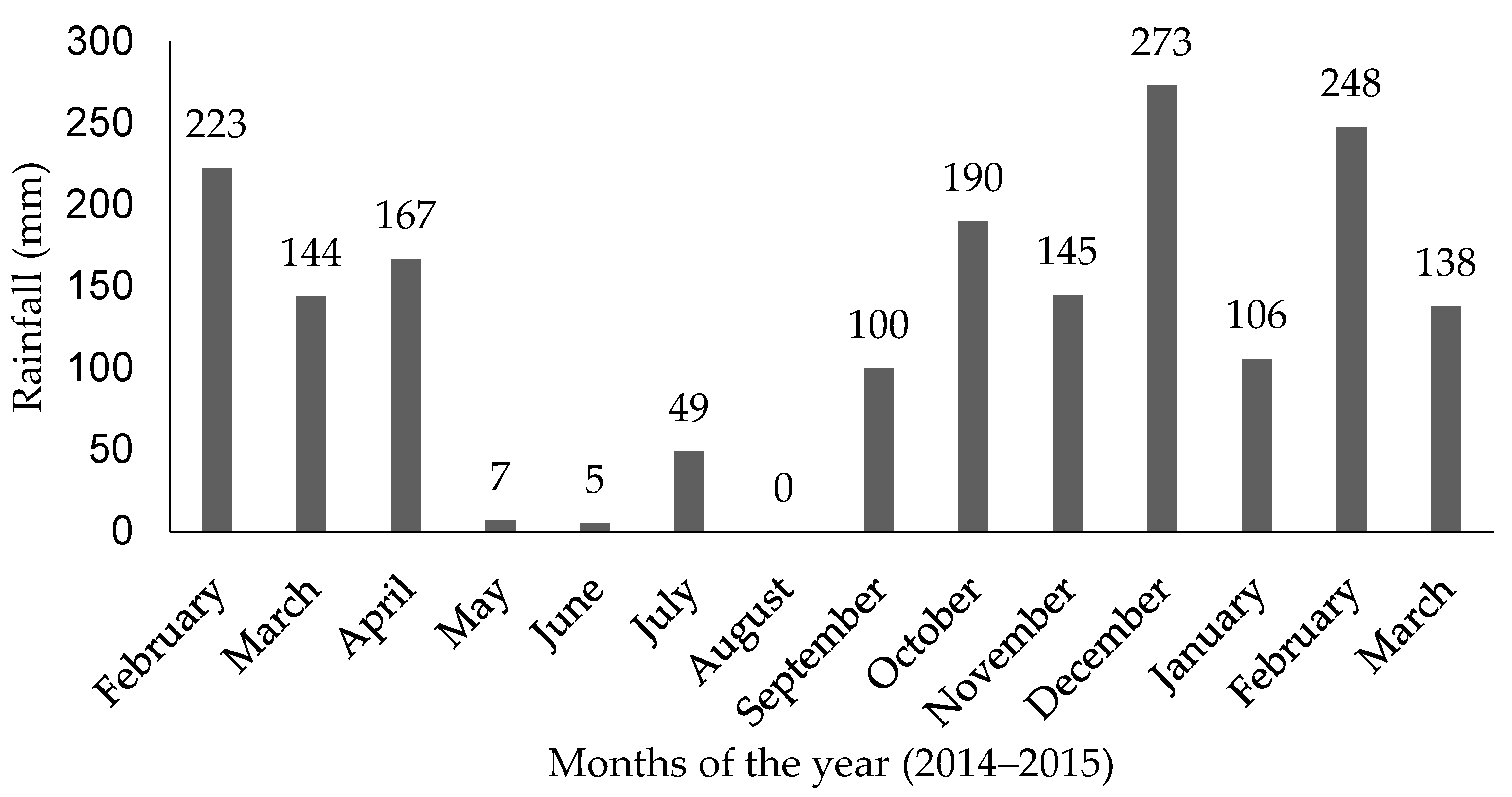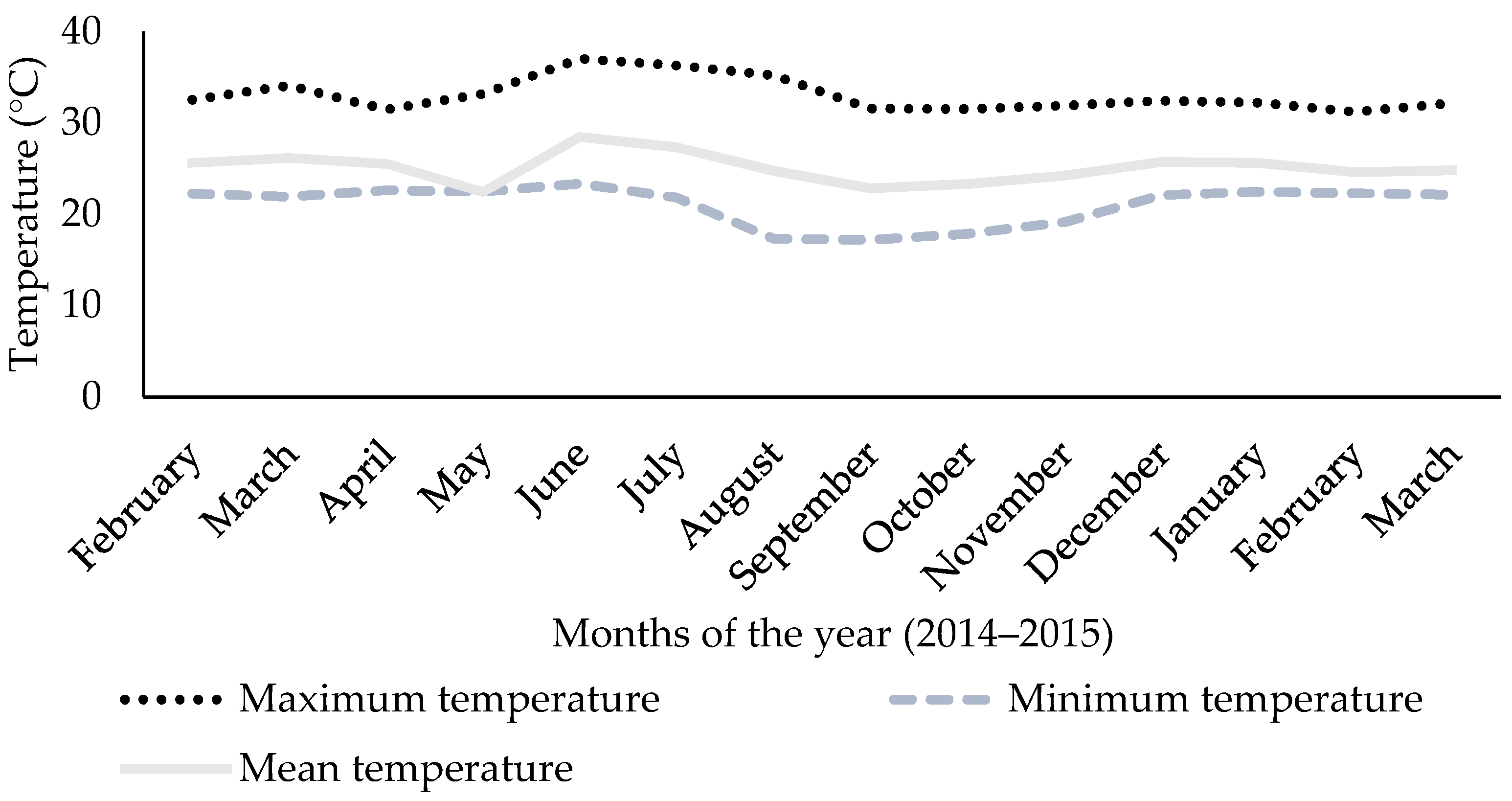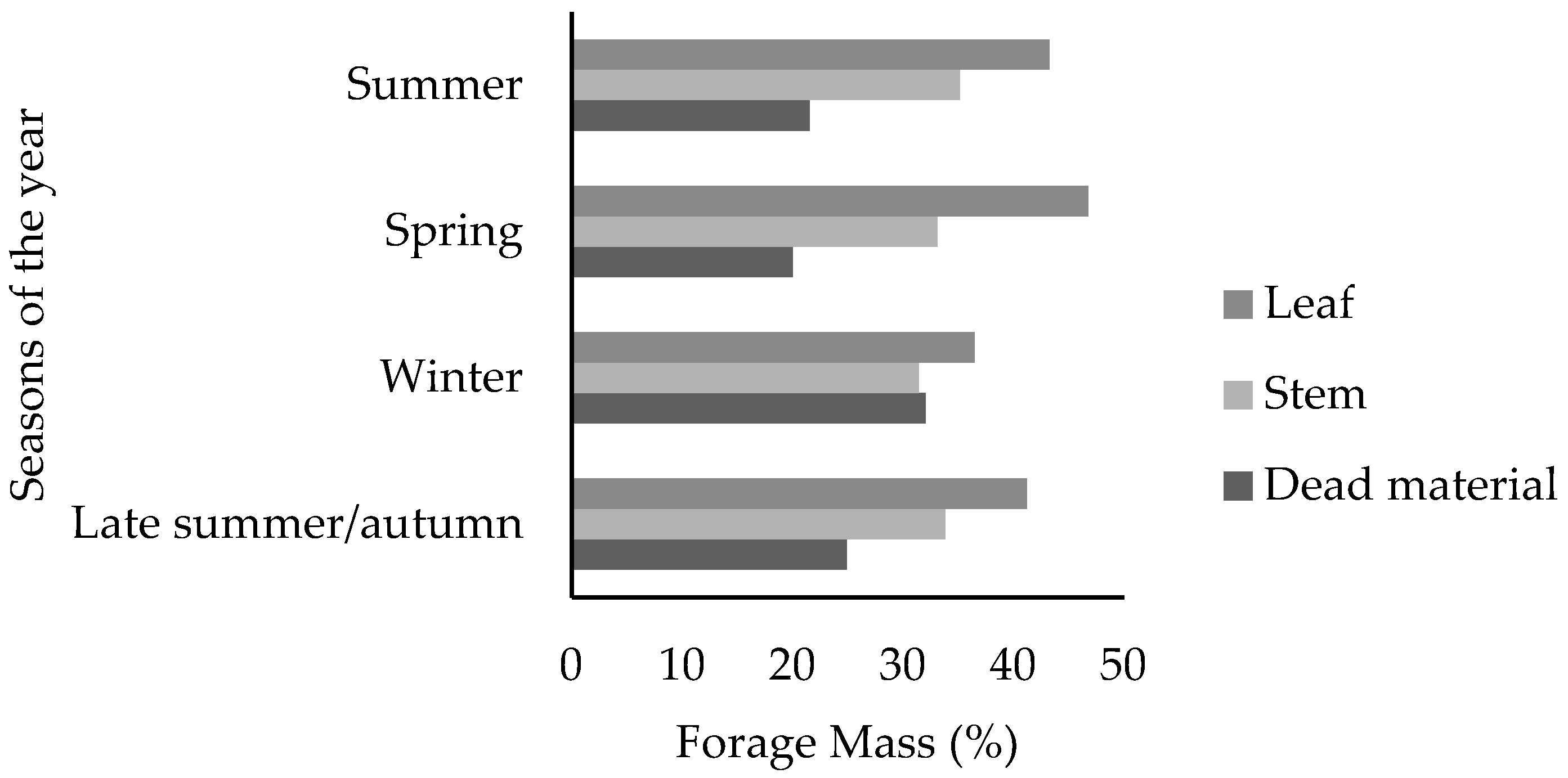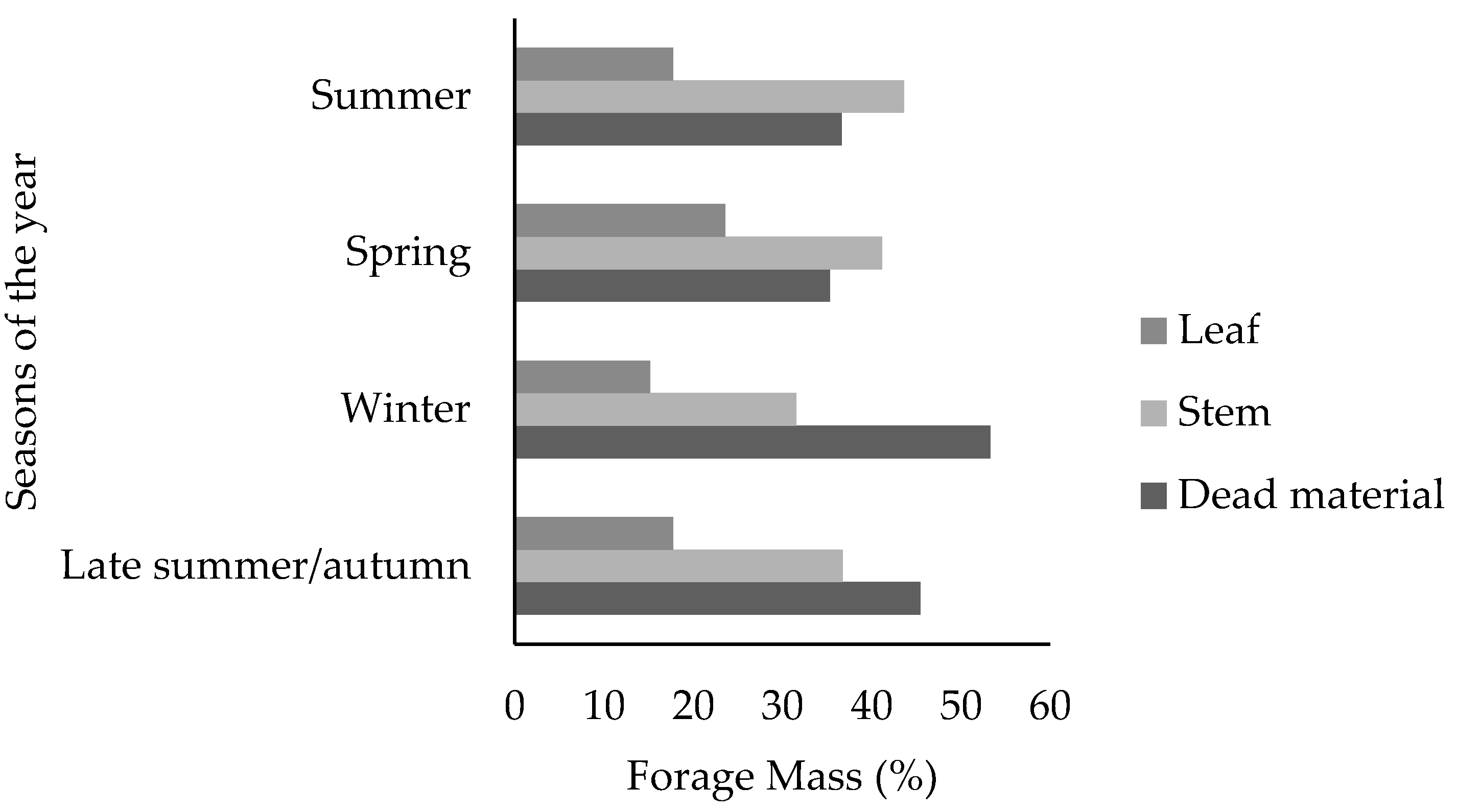1. Introduction
To make competitive the use of pasture as a forage resource for the feeding of ruminants, it is necessary to use the pasture adequately in order to ensure production and harvest efficiency [
1]. Thus, studies that are conducted based on the physiology and ecology of forage grasses are extremely important [
2,
3,
4].
Based on the ecophysiological management of grasses, when the forage canopy reaches 95% light interception (LI), the maximum forage accumulation rate is maintained, while there is sufficient leaf area to intercept almost all incident light [
5]. Subsequent increases in leaf area index occur from 95% LI and, in response to competition for light, the plant initiates an intense stem elongation process, leading newer leaves to be positioned above the older leaves under conditions of full light. This leads to reduced leaf accumulation and increased accumulation of stems and dead material, with an increase in the amount of tissues without photosynthetic (senescent) tissues [
6]. Thus, [
7] demonstrated that the optimal point for interrupting the regrowth of pastures subjected to cutting regimes would actually be the one with the highest average rate of forage accumulation and nutritional quality.
As the pattern of forage accumulation depends on the interception and competition for light, the faster the pasture regrowth, the faster it will be able to be grazed again [
8], which indicates that the management of the grazing interval based on fixed calendars is quite limited and can cause serious damage to forage quality and livestock production [
5].
A practice that has provided a reduced grazing interval and increased bearing capacity of pastures is the nitrogen fertilization. This is because soil nitrogen from the mineralization of organic matter is not sufficient to meet the demand of grasses with productive potential [
9]. Nitrogen is a macronutrient that participates in the structure of several organic compounds, such as proteins and enzymes, and, thus, have direct action on the metabolic function, through the modulation of the expression of nucleic acids and also because it is one of the main components of chlorophyll, due to this the N accelerates the formation and growth of new leaves by increasing the vigor of regrowth after defoliation [
10,
11] and, therefore, can promote the improvement of the economic performance of rural properties [
12]. Although the nitrogen fertilization can be used to accelerate the growth of grasses. The dynamics of nitrogen in the soil is complex due to the high permeability of in the soil, bacterial changes in the N-fertilizer, plus the losses in the form of volatilization, in addition to the variation in the nitrogen requirement of the forages due to the climatic condition and pressure grazing, these factors hinder the reduction losses and maximize the use of N-fertilizer, resulting in increased costs. Because of the different climatic conditions of the seasons, affecting the time necessary for regrowth, plus the search for a more efficient use of nitrogen fertilization, it is hypothesized that grazing control based on 95% of light interception when considering ecophysiological concepts can promote a more efficient recommendation for nitrogen fertilization throughout the seasons.
Thus, the present study aimed to evaluate the agronomic traits in the pre- and post-grazing and the nitrogen use efficiency in the Piatã grass throughout the seasons of the year.
4. Discussion
Nitrogen fertilization accelerated pasture growth, reducing recovery time after grazing, which resulted in reduced intervals and an increased number of grazing cycles. These effects provided higher forage mass as the nitrogen dose increased at all seasons of the year studied. These results were similar to those that were reported by [
18], who evaluated the effect of nitrogen doses (0, 125, 250, 375, and 500 kg ha
−1 N) on the productive characteristics of the
Brachiaria brizantha cv. Piatã.
It was characterized that even in the winter season, marked by climatic deficits (
Figure 1 and
Figure 2), the plant with its nitrogen demand supplied, there is an increase of more than 40% in forage production when compared to the pasture without fertilization, which can represent a higher stocking rate in the most critical period of the year. [
2] evaluated the morphogenic and structural characteristics of guinea grass by combining the frequencies and intensities of grazing over the seasons, and also verified that the ecophysiological grazing management combined with nitrogen fertilization presented superior responses to even in the period of water deficit. [
18] also observed higher forage mass values in the spring/summer season as compared to the autumn/winter season when they evaluated the forage mass production of six grasses (xaraés, mombaça, tanzania, pioneiro, marandu, and estrela) under grazing and fertilized with nitrogen doses (100, 300, 500 and 700 kg ha
−1 N year). The authors justified the results by the higher temperatures which increased plant metabolism. In the present study, the results were also a consequence of weather conditions favorable to pasture growth, characterized by higher rainfall index and nitrogen fertilization (
Figure 1 and
Figure 2). According to [
19], the increase in forage mass production is a function of nitrogen that actively participates in the synthesis of organic compounds, thus forming plant structures, such as molecules of chlorophyll, proteins, vitamins, pigments, and amino acids. Therefore, such results evidenced the need for nitrogen fertilization in the pastures in order to obtain higher yields in tropical regions.
The increases in NUE were below those that were reported by [
20] (57 to 31 kg DM kg
−1 N, with doses from 75 to 300 kg ha
−1 N). According to [
9], the reduced efficiency can be explained by the plant’s lower capacity to absorb and use the nutrient for production, besides possible soil leaching or accumulation in the tissues.
The greater contribution of the leaf blade showed in all seasons of the year results in higher nutritive value, since the leaves are the fraction of the forage plant with the highest digestibility, and in contrast, the lowest nutritive value, due to the higher presence of stem and material dead [
2,
21].
Therefore, although tropical grasses lengthen their internodes to raise the apical meristem for emitting the inflorescence, from the vegetative to the reproductive phase [
22], which for the Piatã grass occurs in the months of January and February, as can be verified in
Figure 3, such behavior was not observed in the present study. Thus, the efficiency of grazing management based on the interruption of pasture growth with 95% LI is independent of greater or lesser doses of nitrogen. Similar behavior to those reported by [
2] with
Panicum maximum Jacq. cv. Tanzania, [
6] with
Brachiaria brizantha cv. Xaraés, [
10] with
Brachiaria brizantha cv. Piatã and [
20] with
Brachiaria decumbens, studies that the grazing management of tropical grasses were based on luminous interception with nitrogen fertilization at different times of the year.
For this reason, it can be considered that grazing management with 95% LI was efficient in promoting a pasture structure with higher proportions of leaf blades while using the rotational stocking method with variable stocking rate. However, the stem proportion was around 32%, which may lead to a perspective that a more frequent grazing management could lead to a higher harvesting efficiency. Thus, the goal of 90% LI could be tested in the future, since sheep are animals with selective behavior in which the tiller select leaf by leaf when grazing, allowing for lengthening the stem.
The increased in percentage of dead tissue during summer/autumn and especially in winter can be explained by unfavorable weather conditions (
Figure 1 and
Figure 2). At these seasons of the year, it is possible that the plant anticipates the death of tillers and reduces the leaf area by accelerating the senescence of older leaves in order to limit their transpiring surface and delay the worsening of the water deficit [
23]. Consequently, there is an increase in the relative participation of dead tissue in the pasture [
8].
The 95% of light interception as the regulator for starting grazing sheep, especially in winter, caused a lower leaf: stem ratio in pre-grazing than in other seasons, and it may have provided a greater proportion of dead material in post-grazing than in other seasons of the year. Probably, the selective behavior of grazing sheep and the less availability of leaves blade in the winter may have caused more intense grazing, reducing the amount of photosynthetically active leaves in post-grazing. In the winter, the lower solar incidence and water available plus the less area of photosynthetically active leaf blade from the intensive grazing sheep can increase the stress in the restoration of the pasture structure with 95% of light interception that can decrease the amount of grazing cycles [
7]. In this way, perhaps the combination between nitrogen fertilization and the change in light interception to 90% can decrease the proportion of dead material and promote a greater residue of photosynthetically active leaf blades, by increasing the availability of leaves for grazing, and thus favoring the forage recovery, which can increase the amount of grazing cycles in this critical period [
8].
Nitrogen doses were efficient in increasing forage mass production of leaf blade at all evaluated seasons. According to [
24], the forage mass production of leaf blade is an important feature for forage growth, since the leaf blade is the most photosynthetically active component in the plant. Thereby, a larger area for energy uptake can promote the greater accumulation of biomass [
12]. Moreover, leaves are the part of the plant with the highest nutritional value [
4].
These results can be explained by favorable climatic factors (
Figure 1 and
Figure 2) that are associated with nitrogen fertilization, which give the plant greater assimilation of nitrogen that stimulates the tillering and, hence, increases the emergence of leaves [
10]. This fact was the main factor responsible for the greater number of grazing cycles at the highest nitrogen dose, as can be observed in
Table 2. Pastures fertilized with 450 kg ha
−1 N obtained four cycles of grazing more than the paddock without fertilization. This also has a direct relationship with the average grazing interval (days), which promoted a reduction of 24 days when comparing to the pasture without fertilization with the highest nitrogen dose. Pasture managed with the rotational stocking method, with a variable stocking rate and higher nitrogen fertilizations, may possibly promote greater individual gain due to the greater number of grazing cycles. In this reality, it is natural to have new tillers, with new leaves and high nutritional value, interesting for productive systems aimed at the termination of animals or greater animal rotation in the system.
The percentage of dead material in post-grazing forage mass during late summer/autumn and winter likely may be increased due to the limitations of weather conditions (
Figure 1 and
Figure 2) due to the higher senescence rates that were recorded in these seasons. Similar results were observed by [
25] in the morphological composition of the forage of xaráes grass, which also varied with the increase of leaf blades throughout the rainy seasons (spring and summer) and the inverse behavior for dead material throughout the year, with higher values in autumn and winter. In addition, the leaf blade percentage in post-grazing forage mass also increased. These results corroborate with the results of [
10], which observed a higher production of leaf blade mass in the Piatã grass receiving doses up to 500 kg ha
−1 N.
The morphological composition of the post-grazing forage mass is a very important productive characteristic, because the higher the participation of the leaf blade component in the remaining forage mass, the lesser the mobilization of organic reserves by the apical meristem for the replacement of leaves, since the faster will be the recovery of the photosynthetic apparatus of the pasture [
8,
26], ensuring the production and continuity of the pasture [
5]. In this way, the balance between maintaining sufficient leaf area for photosynthesis and harvesting large amounts of leaves before senescence should be sought in order to favor rational and efficient pasture exploitation [
3]. According to [
27], after grazing or cutting, in spite of reduced shading, the remaining leaves showed reduced photosynthesis, probably because their development occurred partially under intense shading.
According to [
9], the maximum average rate of forage accumulation occurs when the canopy reaches 95% LI, which is the right moment for the interruption of regrowth, since, from that moment on, the lower leaves become completely shaded by the upper leaves, thus decreasing the photosynthetic activity of leaves, passing from the condition of source of photoassimilates to the drainage condition. Thereby, if the regrowth of pasture was not interrupted, there were subsequent increases in leaf area index, thus reducing the pasture accumulation rate as a function of the increase in respiration rates that result from an increase in the amount of tissues without photosynthetic function (senescent) [
5].
Thus, nitrogen fertilization levels promoted an increase in yield of the Piatã grass, due to the higher photosynthetic efficiency of leaves [
8], that can be observed through the SPAD and LAI indexes (
Table 7). The LAI and SPAD indices, when measured and associated with a 95% light interception control, a value that promotes the minimum of self-shading, provided that the forage is harvested with a high leaf: stem and also of biomass production close to the maximum value, in the moment of the best relationship between quality of chemical composition and biomass production, these values are limited by the factors solar irradiation, water, and soil nutrient availability; due to this, the nitrogen fertilization provided greater tissue flows expressed in the LAI and SPAD index values.
This productivity was predominantly composed in its morphological structure by the high percentage of leaf blade. The percentage of stem elongation was maintained to satisfactory values, since the leaf blade production showed positive linear behavior in as much as the nitrogen fertilization increased. Thus, despite nitrogen accelerating the flow of tissues in the grasses [
19], the use of light interception (95% LI) as a strategy to define the grazing moment provided an efficient harvest of the pasture of piatã grass by the animals, with a greater percentage of leaves and lower percentages of stem and senescent material, regardless of the seasons of the year.
Thus, the use of the grazing frequency target based on a 95% light interception efficiently controlled the stem, especially in the autumn-winter period, when the apical meristem takes up the temperature change, and induces the plant to leave the vegetative stage for the reproductive stage [
9]. This stage change promotes the loss of the pasture structure, due to the increase in stem and dead material, which negatively affects the harvesting process and fiber digestibility by animals.











